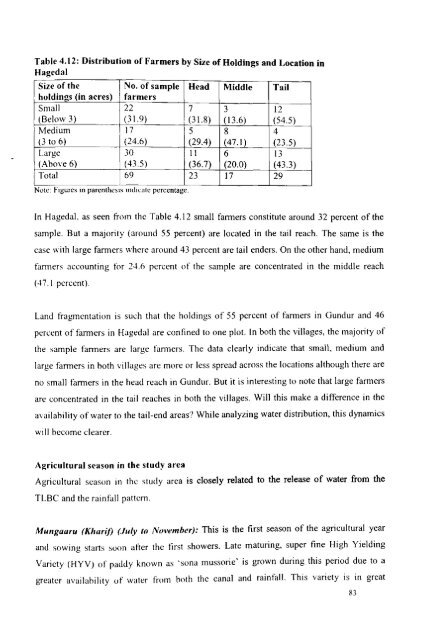Water Users Association and Irrigation Management - Institute for ...
Water Users Association and Irrigation Management - Institute for ...
Water Users Association and Irrigation Management - Institute for ...
You also want an ePaper? Increase the reach of your titles
YUMPU automatically turns print PDFs into web optimized ePapers that Google loves.
Table 4.12: Distribution of Farmers by Size of Holdings <strong>and</strong> Location in<br />
Hagedal<br />
Size of the No. of sample Head Middle Tail<br />
holdings (in acres) farmers<br />
Small 22 7 3 12<br />
(Below 3) (31.9) (31.8) (13.6) (54.5)<br />
Medium 17 5 8 4<br />
(3 to 6) (24.6) (29.4) (47.1) (23.5)<br />
Large 30 I I 6 13<br />
(Above 6) (43.5) (36.7) (20.0) (43.3)<br />
Total 69 23 17 29<br />
. .<br />
Note. FIgures In parenthesIS IndIcate percentage .<br />
In HagedaL as seen from the Table 4.12 small fanners constitute around 32 percent of the<br />
sample. But a majority (around 55 percent) are located in the tail reach. The same is the<br />
case with large fanners where around 43 percent are tail enders. On the other h<strong>and</strong>, medium<br />
fanners accounting <strong>for</strong> 24.6 percent of the sample are concentrated in the middle reach<br />
(47.1 percent).<br />
L<strong>and</strong> fragmentation is such that the holdings of 55 percent of fanners in Gundur <strong>and</strong> 46<br />
percent of fanners in Hagedal are confined to one plot. In both the villages, the majority of<br />
the sample fanners are large fanners. The data clearly indicate that small, medium <strong>and</strong><br />
large fanners in both villages are more or less spread across the locations although there are<br />
no small fanners in the head reach in Gundur. But it is interesting to note that large fanners<br />
are concentrated in the tail reaches in both the villages. Will this make a difference in the<br />
availability of water to the tail-end areas') While analyzing water distribution, this dynamics<br />
will become clearer.<br />
Agricultural season in the study area<br />
Agricultural season in the study area is closely related to the release of water from the<br />
TLBC <strong>and</strong> the rainfall pattern.<br />
Mungaaru (Kharij) (July to November): This is the first season of the agricultural year<br />
<strong>and</strong> sowing starts soon aHer the first showers. Late maturing, super fine High Yielding<br />
Variety (HYV) of paddy known as 'sona mussorie' is grown during this period due to a<br />
greater availability of water from both the canal <strong>and</strong> rainfall. This variety IS In great<br />
83
















